| Wheat stem rust |
|
|
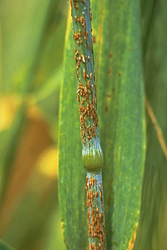 |
|
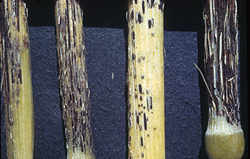 |
| C11.1. Urediniospores (the repeating stage) in pustules on wheat. |
|
C.11.2. Teliospores (the survival stage) in pustules on wheat. |
| |
|
|
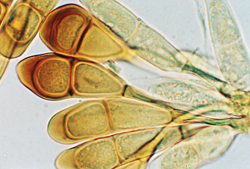 |
|
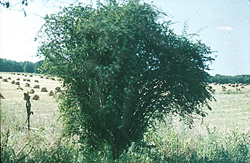 |
| C11.3. Teliospores of Puccinia graminis f. sp. tritici (light micrograph). |
|
C11.4. Common barberry (Berberis vulgaris), the alternate host of Puccinia graminis. |
|
|
|
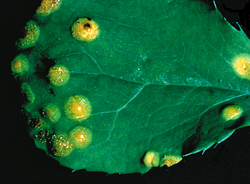 |
|
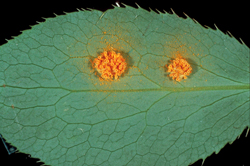 |
|
C11.5. Pycnia with honeydew on barberry leaf. |
|
C11.6. Aeciospores on barberry leaf. These spores infect wheat. |
| |
|
|
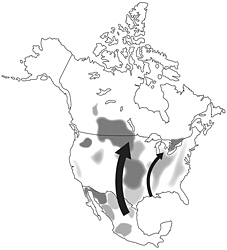 |
|
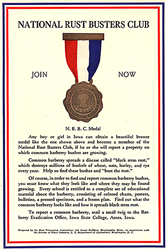 |
| C11.7. The Puccinia pathway. Each year, urediniospores are blown from southern states and Mexico to Canada. Shading indicates amounts of wheat production in various areas, with darker areas having higher production. |
|
C11.8. A "Rust Buster" medal given to schoolchildren who helped in the barberry eradication program.
|
|
|
|
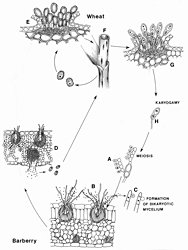 |
|
|
| Disease cycle of stem rust of wheat. |
|
|
|
|
|
Cedar-apple rust |
|
|
|
|
|
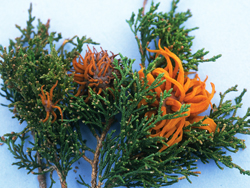 . . |
|
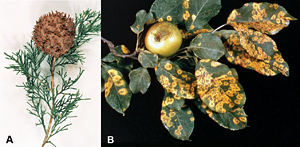 |
C11.9. The production of basidiospores from the gall of the cedar-apple rust fungus on juniper.
|
|
C11.10. A, gall caused by cedar-apple rust on red cedar, also called juniper. The orange spore horns have withered after basidiospore production. B, cedar-apple rust symptoms on apple following infection by basidiospores from juniper. Later, aeciospores are produced on the lower leaf surfaces. |
|
|
|
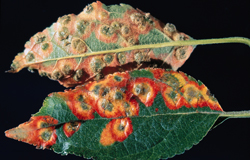 |
|
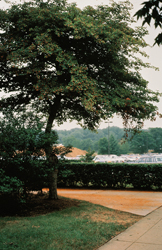 |
|
C11.11. Cedar-apple rust on an apple leaf. Pycnia form on the upper side, and aeciospores are released from the lower side.
|
|
C11.12. Masses of aeciospores shower from an infected hawthorn tree. This quince rust pathogen is closely related to the cedar-apple rust fungus and shares junipers as alternate hosts. The aeciospores on the sidewalk have failed to infect a juniper. |
| |
|
|
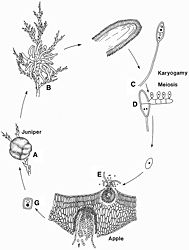 |
|
|
| Disease cycle of cedar-apple rust. |
|
|
|
|
|
Soybean rust |
|
|
|
|
|
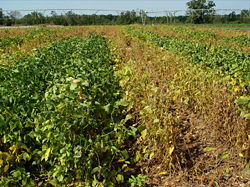 |
|
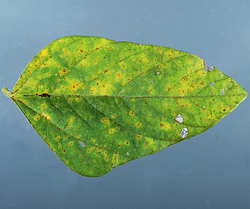 |
| C11.13. Soybeans infected and not infected with Asian soybean rust, caused by Phakopsora pachyrhizi, in a fungicide trial in Attapulgus, Georgia, 2006. |
|
C11.14. Asian rust of soybean caused by Phakopsora pachyrhizi on a leaf.
|
|
|
|
|
|
White pine blister rust |
|
|
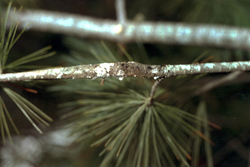 |
|
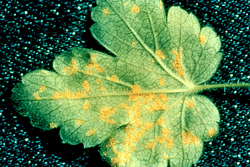 |
| C11.15. Cronartium ribicola, which causes white pine blister rust, survives in blister rust cankers. |
|
C11.16. Urediniospores produced on a Ribes leaf. The repeating stage of this rust fungus is on the alternate host. |
|
|
|
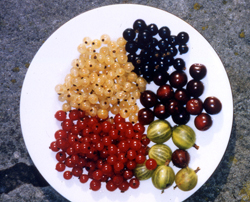 |
|
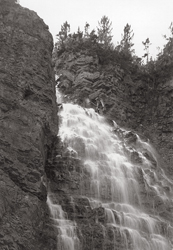 |
C11.17. Plate of black, red, yellow, and green currants and gooseberries (Ribes species).
|
|
C11.18. A crewman spraying a Ribes bush with an herbicide along a waterfall in Glacier National Park, in Montana. This was part of the alternate host eradication program to prevent white pine blister rust. |
|
|
|
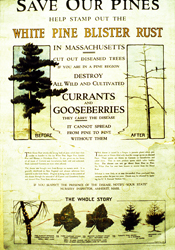 |
|
|
| C11.19. A poster warning that Ribes species are the alternate host of the white pine blister rust fungus. |
|
|
|
|
|
|
Flower rusts
|
|
|
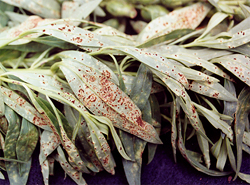 |
|
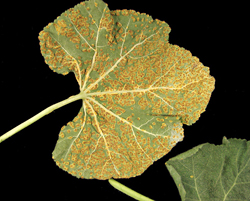 |
| C11.20. Snapdragon rust, caused by Puccinia antirrhini. Brown pustules of urediniospores are apparent on the lower leaf surfaces and are surrounded by chlorotic haloes. Subsequent outbreaks of rust may give the pustules a circular pattern or sets of concentric rings. |
|
C11.21. Hollyhock rust, caused by Puccinia malvacearum, a common problem in spring on hollyhocks.
|
|
|
|
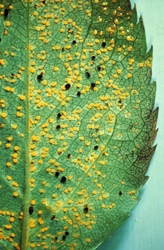 |
|
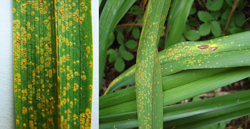 |
| C11.22. Rose rust (Phragmidium mucronatum) urediniospores. This is an autoecious rust fungus. It is possible to observe all spore stages on roses at different times. |
|
C11.23. Daylily rust, caused by Puccinia hemerocallidis.
|
|
|
|
